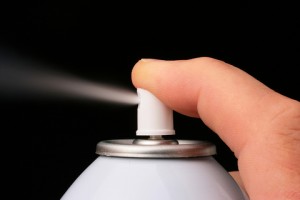An Overview of Inhalant Abuse
 Stories about inhalant abuse often focus on people who are younger than 18. These young people aren’t able to waltz into a store to buy liquor and they may not be able to scrape together enough money to pay for drugs on the street, but they can open up the cabinets in the house and find a substance that can bring them a sense of euphoria, even if that sensation is fleeting. While it may be true that young people turn to inhalants in a quest for intoxication, it’s also true that older people can and do abuse inhalants for their own sense of pleasure. In fact, the Substance Abuse and Mental Health Services Administration reports that 54 percent of people who enroll in treatment programs for inhalant abuse are 18 or older. Perhaps it’s time to acknowledge that anyone could develop addictions to these very real drugs, and perhaps it’s time for people who abuse these drugs to enroll in treatment programs that could help.
Stories about inhalant abuse often focus on people who are younger than 18. These young people aren’t able to waltz into a store to buy liquor and they may not be able to scrape together enough money to pay for drugs on the street, but they can open up the cabinets in the house and find a substance that can bring them a sense of euphoria, even if that sensation is fleeting. While it may be true that young people turn to inhalants in a quest for intoxication, it’s also true that older people can and do abuse inhalants for their own sense of pleasure. In fact, the Substance Abuse and Mental Health Services Administration reports that 54 percent of people who enroll in treatment programs for inhalant abuse are 18 or older. Perhaps it’s time to acknowledge that anyone could develop addictions to these very real drugs, and perhaps it’s time for people who abuse these drugs to enroll in treatment programs that could help.
Danger in the Home
People who abuse inhalants aren’t interested in masking an unpleasant smell with another scent that’s more appealing. They’re looking for a very specific chemical that’s produced when a chemical comes in contact with the air. In these reactions, particles swirl through the air, and sniffing those chemicals can bring about a radical change in the user’s mind. On a daily basis, almost everyone has run into a substance that could be used as an inhalant. Most people avert their noses when they come into contact with these substances, but those who have an addiction seek them out.
Inhalants are often grouped into categories, including:
- Volatile solvents: paint thinner, nail polish remover, gasoline, felt-tip markers
- Aerosols: hair spray, spray paint, whipping cream sprays
- Gases: lighters with butane, propane tanks, nitrous oxide
- Nitrites: illicit substances sometimes sold as “room deodorizer”
Some people who abuse solvents buy products for their use, but many people with this addiction simply scour the house for the products they want, and they may keep track of where these products are at all times. It only takes a small amount of a substance to pack a big punch, so one small can of a product could last a user for months or even for years. This is, in part, what makes the addiction so difficult to combat. The substances are really everywhere, and they last a long time. It’s almost impossible to remove the risk from a standard home, too, as many of these products are necessary in order to keep a household running as it should.
Modes of Abuse
 People who abuse inhalants may simply hold the items close to their noses and breathe deeply. This is a technique that works especially well with pens and other items that can quickly be resealed. Some people who inhale also place the items inside paper bags, and they hold those bags close to their noses and mouths and breathe deeply. People may also soak small pieces of cloth with inhalant substances, and they may place that rag in their mouths and breathe through their mouths.
People who abuse inhalants may simply hold the items close to their noses and breathe deeply. This is a technique that works especially well with pens and other items that can quickly be resealed. Some people who inhale also place the items inside paper bags, and they hold those bags close to their noses and mouths and breathe deeply. People may also soak small pieces of cloth with inhalant substances, and they may place that rag in their mouths and breathe through their mouths.
This isn’t a glamorous addiction, and it’s not something that most adults would do in public. Where people who are addicted to alcohol might not feel any compunction at all about swirling their drinks in a crowded room full of other people, those who inhale may not whip out their drugs in the middle of a party or while watching television with the children. But people like this may be suspiciously absent for long periods of time, and they might return from those solo trips in an altered state. People like this may also spend a significant amount of time in the garage or digging underneath the sink, where these chemicals are typically held.
A Changing Brain
 The chemicals inside inhalants can vary dramatically, as can the sensations they bring about, but most inhalants depress the central nervous system. A quick whiff of inhalants can slow down breathing rates and heart rates, making people feel relaxed and just a little bit loopy. These are the same effects that might be delivered with multiple drinks of alcohol, but inhalants can produce them almost immediately. The sensations don’t last long, however, so people who abuse these substances may be required to take hits of drugs over and over again to make the sensations last.
The chemicals inside inhalants can vary dramatically, as can the sensations they bring about, but most inhalants depress the central nervous system. A quick whiff of inhalants can slow down breathing rates and heart rates, making people feel relaxed and just a little bit loopy. These are the same effects that might be delivered with multiple drinks of alcohol, but inhalants can produce them almost immediately. The sensations don’t last long, however, so people who abuse these substances may be required to take hits of drugs over and over again to make the sensations last.
Some people engage in repeated inhalant abuse because they enjoy the sedation the drugs can bring. The National Institute on Drug Abuse (NIDA) reports, however, that some inhalants can bring about a boost of dopamine inside the brain of a user. This is the same chemical the brain releases when it’s exposed to something wonderful, like the face of a loved one or the smell of a delicious meal. The signal is designed to tell the brain to pay attention, and to seek out that element in the future. A dopamine amendment is responsible for many of the reinforcing aspects of common drugs like cocaine and heroin, and since inhalants can cause these same changes, these drugs might be just as addictive and just as dangerous.
Dangerous Habit
Substances that can be abused as inhalants may be legal, but most of these products contain very strict manufacturers’ warnings about how they should be used and what consumers should do in order to keep themselves safe from damage. In most cases, manufacturers recommend that people use the substances in well-ventilated areas. Since people who inhale these drugs want to experience a change in sensation, they remove all ventilation.
At low levels of intoxication, they can experience:
- Drowsiness
- Lightheadedness
- Agitation
- Lack of inhibition
At high doses, people can become dizzy and lethargic. They may have slowed reaction times and poor muscle control. They may even lose consciousness due to the severe depression these drugs can cause. The loss of consciousness may be due, in part, due to a lack of oxygen. Since very intoxicated people aren’t breathing properly, and they’re not taking in air as they should, their bodies may just shut down. If the proper amount of oxygen isn’t restored, portions of the brain can be damaged, and people may develop difficulties with memory, planning and problem-solving. It’s not clear if these problems resolve when the addiction has been resolved.
 Inhaling these toxic substances can also cause the destruction of myelin, a substance that covers the nerve fibers throughout the body. According to the NIDA, people who abuse inhalants can lose so much myelin that their bodies can’t transmit smooth signals from the brain to the muscles, and people may develop muscle spasms or shaking hands and feet. Some people even develop difficulty with walking and talking, since their myelin levels have been so very depleted.
Inhaling these toxic substances can also cause the destruction of myelin, a substance that covers the nerve fibers throughout the body. According to the NIDA, people who abuse inhalants can lose so much myelin that their bodies can’t transmit smooth signals from the brain to the muscles, and people may develop muscle spasms or shaking hands and feet. Some people even develop difficulty with walking and talking, since their myelin levels have been so very depleted.
The U.S. Drug Enforcement Administration reports that some inhalants cause an increase in heart rate, and in some people, that rapid pace is erratic and strange. The heart isn’t really working as it should, and it can’t pump blood effectively, and people with this issue could die within minutes of inhaling a substance. This isn’t a side effect that’s dependent on doses, meaning that people could die the very first time they use an inhalant, but it is a very real possibility for anyone who uses the drugs.
Some women who abuse inhalants do so while they’re pregnant, and they force their unborn babies to develop addictions as a result. In a study of this issue, in the journal Archives of Disease in Childhood, researchers found that babies who were born to inhalant-abusing mothers were prone to crying excessively, and they were shaky and unwilling to eat well. The babies struggled like this for days, and it’s unclear if they had long-term damage as a result. At the time of the study, the researchers couldn’t even find a treatment that could help. Mothers who abuse these drugs could be doing their babies a great disservice, this study suggests.
Some people who abuse inhalants focus their behaviors only on this particular type of chemical abuse, but according to a study in the journal Drug and Alcohol Dependence, many people who use inhalants also use alcohol. Here, researchers found that of those who had an inhalant disorder, most had an existing alcoholism issue. Mixing and matching drugs in this way could be catastrophic, as alcohol is also a sedative drug. People who abuse alcohol and inhalants could be slowing down their bodies to such a degree that they simply don’t wake up, and they may find that stopping the abuse of even one of these substances is difficult or impossible without help.
Seeing the Signs
 Some signs of inhalant abuse are relatively easy for families to spot. They may see the person they love inhaling fumes, for example, or they may notice that the person heads straight to the garage or the chemical cupboard when faced with a difficult situation, and emerges seeming giddy and silly just a few moments later. But, as mentioned, some people who abuse these drugs are savvy about how they’re perceived by their families, and they may go to great lengths to keep their abuse hidden. Spotting an addiction in people like this is slightly more difficult, but it’s certainly not impossible.
Some signs of inhalant abuse are relatively easy for families to spot. They may see the person they love inhaling fumes, for example, or they may notice that the person heads straight to the garage or the chemical cupboard when faced with a difficult situation, and emerges seeming giddy and silly just a few moments later. But, as mentioned, some people who abuse these drugs are savvy about how they’re perceived by their families, and they may go to great lengths to keep their abuse hidden. Spotting an addiction in people like this is slightly more difficult, but it’s certainly not impossible.
People who abuse inhalants are putting very sensitive tissues in frequent contact with caustic and dangerous chemicals. As a result, they may develop chapped lips, bleeding nasal tissue, bloodshot eyes and a runny nose. All of these symptoms could be blamed on something innocent, like a cold, but if they just don’t seem to disappear, they could be a good indication that something difficult is taking place. People who abuse inhalants may also keep stockpiles of their substances of abuse in secret places, like their purses or in their nightstands. If solvents and lighters appear in these places, and the person has no need for them but is desperate to keep them, an inhalant issue may be to blame.
Inhalants are also heavily scented, and the odors they produce tend to cling to the hair, clothing and skin of people who abuse them. As a result, people who abuse inhalants may have a strange sort of odor clinging to them almost all the time, and in some cases, they may even have specks of solvents or paint on their faces. These visual and olfactory cues could be dead giveaways that an addiction is in play, and it could merit an intervention from the family.
As the addiction moves forward and the damage begins to build, people with these addictions may also complain of nausea and muscle weakness on a regular basis. They may also have frequent headaches, and seem distant and inattentive. People who use these drugs may also experience severe weight loss. Physical problems like this could be attributed to other issues, of course, but they might be another clue a family could watch for.
Getting Help
In a treatment program for inhalant abuse, treatment professionals work hard to determine why the person began abusing inhalants, and the team then works on providing the person with other tools that could be used to handle that same trigger. For people who abuse inhalants, the discussion may revolve around abuse. In a study of childhood abusers of inhalers, in the American Journal of Public Health, researchers found a direct connection between inhalant abuse and childhood abuse. Some adults may have started their inhalant habit early in life due to abuse, and they may need help as adults in order to process that damage and move forward in a healthier manner in the future.
At The Orchid, we believe that many addictions have their roots in a deep and persistent injury a person faced earlier in life. For women, in particular, drugs of abuse often seem like an appropriate way to deal with a psychic pain, and women may lean on drugs for years instead of getting the help they need in order to heal. We can help. Our program provides intensive therapy that can help a woman to make new connections and really move past the injuries that she’s endured in the past. We also provide intensive relapse prevention counseling, so our clients can return home to temptation without feeling compelled to fall back into bad habits. If you or someone you know needs our help, please call. We have operators standing by around the clock to answer your questions.
